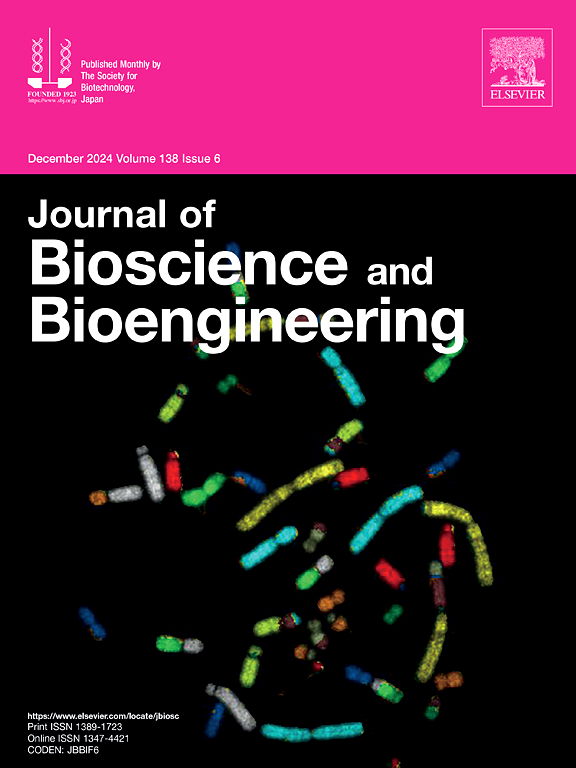添加大麦烧酒蒸馏副产物上清液增强中国仓鼠卵巢细胞抗体产生。
IF 2.9
4区 生物学
Q3 BIOTECHNOLOGY & APPLIED MICROBIOLOGY
引用次数: 0
摘要
在培养液中添加大麦烧酒蒸馏副产物上清(BX2),可提高中国仓鼠卵巢(CHO)细胞的抗体产量。为了预测添加BX2后的抗体产量,采用响应面法在不同的BX2条件下进行了补料分批培养实验。与不添加BX2的对照组相比,BX2的补充预计可使产生igg的CHO-MK1、CHO-MK2、CHO-DG44和产生fc融合蛋白的CHO-DG44细胞的抗体产量分别提高138%、146%、120%和240%。BX2主要由27% (w/w)结合氨基酸、19% (w/w)游离氨基酸、15% (w/w)有机酸、14% (w/w)甘油、14% (w/w)结合糖、6% (w/w)灰分和5% (w/w)可溶性固体中的游离糖组成。利用反相高效液相色谱法将BX2大致分为游离组分(如糖、氨基酸、有机酸和甘油部分)和结合组分(如多糖、多肽、肽链糖和糖基化氨基酸部分)。在产生IgG的CHO-MK2细胞的培养中,添加BX2或其结合成分分别使IgG的产生提高了170%和117%。相比之下,游离组分组分将IgG的产量降低到没有BX2时的73%。这些结果表明,BX2通过多种组分的联合作用而不是单一组分来增强抗体的产生。本研究表明,BX2是一种有效的添加剂,可提高CHO细胞在工业应用中常用的高效培养基中产生抗体。本文章由计算机程序翻译,如有差异,请以英文原文为准。
Enhanced antibody production in Chinese hamster ovary cell cultures supplemented with barley shochu distillation by-product supernatant
Antibody production in Chinese hamster ovary (CHO) cell culture was enhanced by supplementing the culture medium with barley shochu distillation by-product supernatant (BX2). To predict antibody production following BX2 addition, fed-batch culture experiments were conducted under varying BX2 conditions using a response surface methodology. BX2 supplementation was predicted to improve antibody production by 138 %, 146 %, 120 %, and 240 % in IgG-producing CHO-MK1, CHO-MK2, CHO-DG44, and Fc-fusion protein-producing CHO-DG44 cells, respectively, compared to controls without BX2. BX2 consisted primarily of 27 % (w/w) bound amino acids, 19 % (w/w) free amino acids, 15 % (w/w) organic acids, 14 % (w/w) glycerol, 14 % (w/w) bound sugars, 6 % (w/w) ash, and 5 % (w/w) free sugars within the soluble solids. BX2 was roughly fractionated into free components (e.g., sugars, amino acids, organic acids, and glycerol fraction) and bound components (e.g., polysaccharides, peptides, peptide-linked sugars, and glycosylated amino acids fraction) using reverse-phase high-performance liquid chromatography. In cultures of IgG-producing CHO-MK2 cells, the addition of BX2 or its bound components enhanced IgG production by 170 % and 117 %, respectively. In contrast, the free components fraction reduced IgG production to 73 % of that observed without BX2. These results suggest that BX2 enhances antibody production through the combined action of multiple components rather than a single component. This study demonstrates that BX2 is an effective additive for enhancing antibody production in CHO cells cultured in high-performance medium typically used in industrial applications.
求助全文
通过发布文献求助,成功后即可免费获取论文全文。
去求助
来源期刊

Journal of bioscience and bioengineering
生物-生物工程与应用微生物
CiteScore
5.90
自引率
3.60%
发文量
144
审稿时长
51 days
期刊介绍:
The Journal of Bioscience and Bioengineering is a research journal publishing original full-length research papers, reviews, and Letters to the Editor. The Journal is devoted to the advancement and dissemination of knowledge concerning fermentation technology, biochemical engineering, food technology and microbiology.
 求助内容:
求助内容: 应助结果提醒方式:
应助结果提醒方式:


